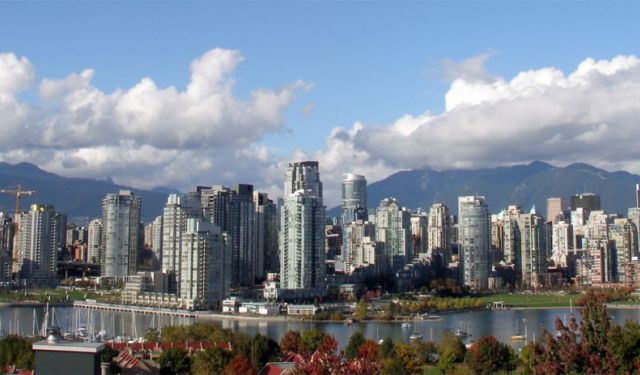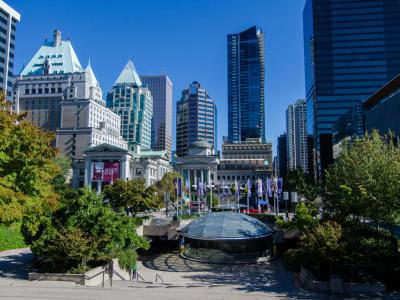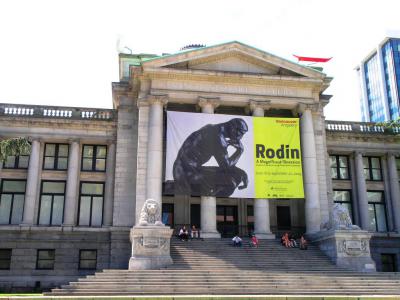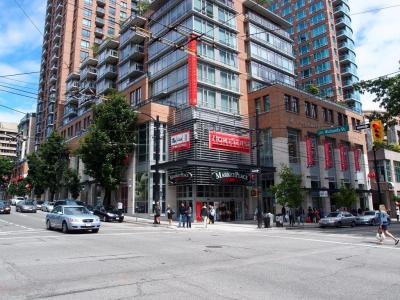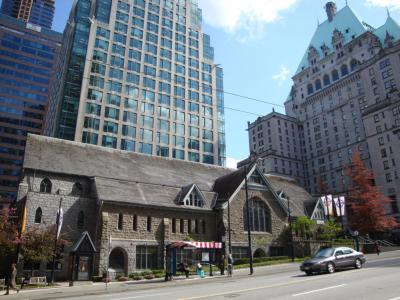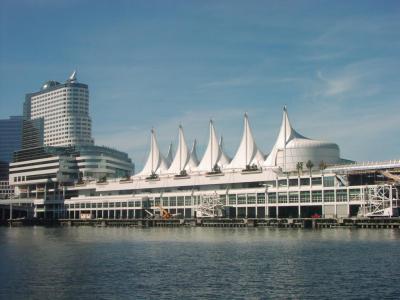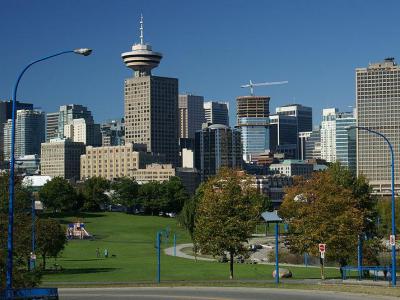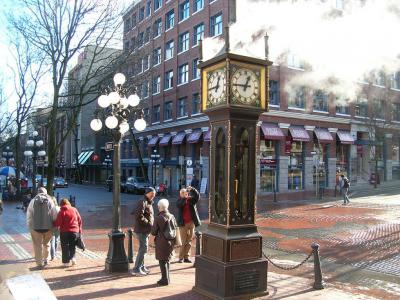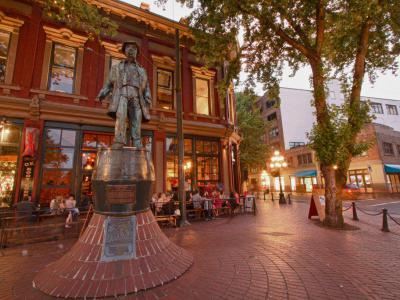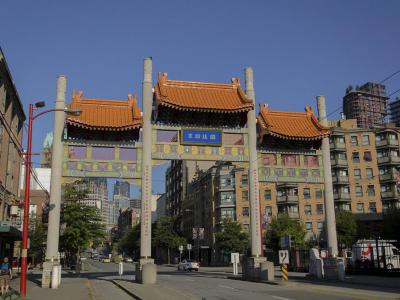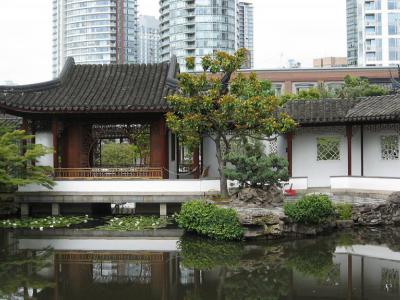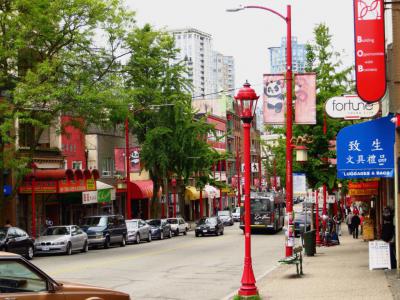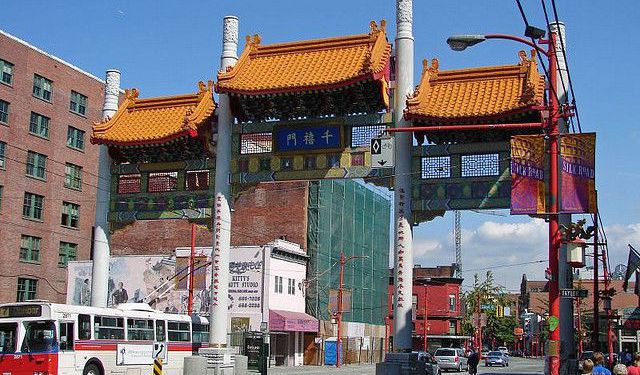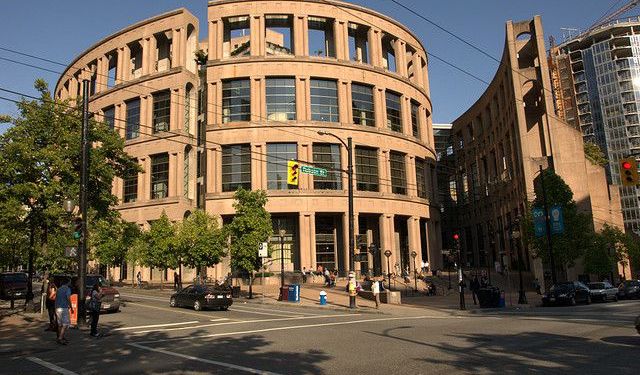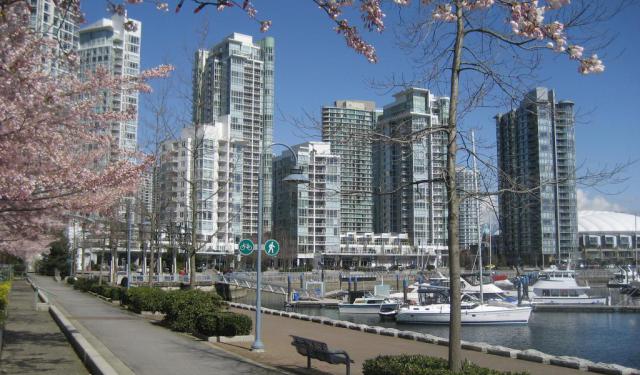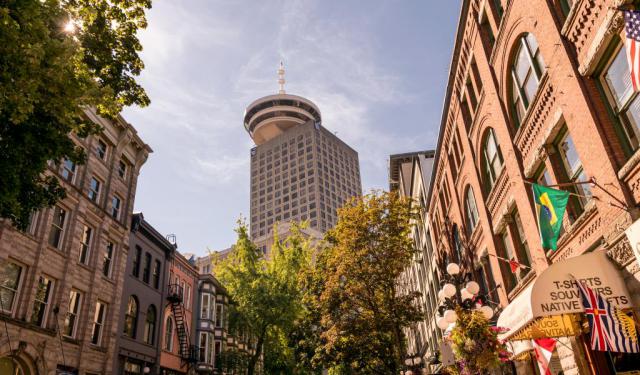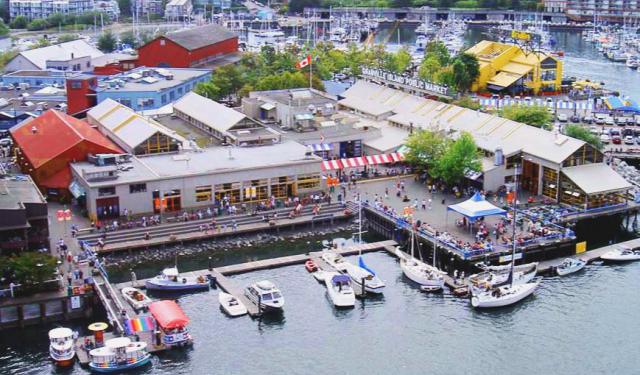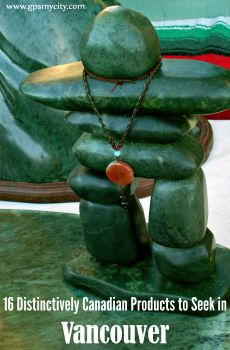Audio Guide: Vancouver Introduction Walking Tour (Self Guided), Vancouver
A bustling seaport on the west coast of Canada, Vancouver is among the country's densest and most ethnically diverse cities. It is also one of British Columbia's youngest cities. Prior to the Europeans, the Vancouver area had been inhabited – for almost 10,000 years – by Aboriginal tribes: Squamish, Musqueam, and Tsleil-Waututh (Burrard). The explorer Simon Fraser and his crew were the first known white men to set foot on the site of today's Vancouver, in 1808. Yet the first European settlement in the area – McCleery's Farm on the Fraser River – appeared only in 1862.
The future city stemmed from the spot called Gastown, which grew around a makeshift tavern on the western edges of Hastings Mill, built in 1867 by one “Gassy Jack”. This site is now marked by the Gastown steam clock. By 1870, the settlement had evolved into a townsite and was named "Granville" in honour of the then-British Secretary of State for the Colonies, Lord Granville. Upon its incorporation as a city, in 1886, the place was renamed "Vancouver" after George Vancouver, who explored the inner harbour of Burrard Inlet in 1792.
The Canadian Pacific Railway transcontinental railroad, extended to Vancouver in 1887, proved to be a vital trade link between Asia, Eastern Canada, and Europe, and effectively transformed the city into a major port on the Pacific, becoming the largest in Canada and most diversified in North America.
Today, Vancouver is also a popular film destination, nicknamed "Hollywood North", with thriving art-, theatre-, and music scenes. The Vancouver Art Gallery is known worldwide for its works by regional artists. Surrounded by mountains, the city is also famous for tourism, its second-largest industry. Vancouver is consistently named among the top five cities in the world for quality of life, which in turn gave rise to the term “Vancouverism” denoting a specific urban planning philosophy.
To explore Vancouver's historical, cultural, and other delights in more detail, take this self-guided introductory walk!
The future city stemmed from the spot called Gastown, which grew around a makeshift tavern on the western edges of Hastings Mill, built in 1867 by one “Gassy Jack”. This site is now marked by the Gastown steam clock. By 1870, the settlement had evolved into a townsite and was named "Granville" in honour of the then-British Secretary of State for the Colonies, Lord Granville. Upon its incorporation as a city, in 1886, the place was renamed "Vancouver" after George Vancouver, who explored the inner harbour of Burrard Inlet in 1792.
The Canadian Pacific Railway transcontinental railroad, extended to Vancouver in 1887, proved to be a vital trade link between Asia, Eastern Canada, and Europe, and effectively transformed the city into a major port on the Pacific, becoming the largest in Canada and most diversified in North America.
Today, Vancouver is also a popular film destination, nicknamed "Hollywood North", with thriving art-, theatre-, and music scenes. The Vancouver Art Gallery is known worldwide for its works by regional artists. Surrounded by mountains, the city is also famous for tourism, its second-largest industry. Vancouver is consistently named among the top five cities in the world for quality of life, which in turn gave rise to the term “Vancouverism” denoting a specific urban planning philosophy.
To explore Vancouver's historical, cultural, and other delights in more detail, take this self-guided introductory walk!
How it works: Download the app "GPSmyCity: Walks in 1K+ Cities" from Apple App Store or Google Play Store to your mobile phone or tablet. The app turns your mobile device into a personal tour guide and its built-in GPS navigation functions guide you from one tour stop to next. The app works offline, so no data plan is needed when traveling abroad.
Vancouver Introduction Walking Tour Map
Guide Name: Vancouver Introduction Walking Tour
Guide Location: Canada » Vancouver (See other walking tours in Vancouver)
Guide Type: Self-guided Walking Tour (Sightseeing)
# of Attractions: 11
Tour Duration: 2 Hour(s)
Travel Distance: 3.7 Km or 2.3 Miles
Author: DanaOffice
Sight(s) Featured in This Guide:
Guide Location: Canada » Vancouver (See other walking tours in Vancouver)
Guide Type: Self-guided Walking Tour (Sightseeing)
# of Attractions: 11
Tour Duration: 2 Hour(s)
Travel Distance: 3.7 Km or 2.3 Miles
Author: DanaOffice
Sight(s) Featured in This Guide:
- Robson Square
- Vancouver Art Gallery
- Robson Street
- Christ Church Cathedral
- Canada Place
- Vancouver Lookout
- Gastown Steam Clock
- Maple Tree Square
- Millennium Gate
- Dr. Sun Yat-Sen Garden
- East Pender Street
1) Robson Square
Robson Square stands as a distinguished civic hub and communal plaza located in the heart of Downtown Vancouver. Encompassing an expansive area of three city blocks, it spans over 1.3 million square feet. The visionary local architect Arthur Erickson is the creative mind behind its design, with its construction reaching completion in 1983. At its core lies an underground expanse that is sheltered and distinctive.
The focal point of the square is the Law Courts, a structure crowned with a glass canopy that shelters 35 courtrooms, situated within the southern block. Meanwhile, the central block houses offices of the provincial government and more recently, sections of the downtown satellite campus of the University of British Columbia on its lower level.
Robson Square's design, inspired by Erickson's style, uses concrete and eco-conscious elements. It has seating steps, open areas, and a small tree-adorned enclave. The layout brings in natural light and air, with three cascading waterfalls above the central block. These waterfalls mask city noise and cool the complex with 3,000+ cubic meters of water.
An underground outdoor skating rink beneath Robson Square connects to the northern block with the Vancouver Art Gallery. It's the city's only free public outdoor skating rink, doubling as a space for various gatherings like Ballroom and Salsa dancing in warmer months. This spot is at the heart of Vancouver's street dance scene.
Especially in summer, Robson Square thrives with diverse sights and activities. From street performers to dancers practicing, protesters supporting various causes, and artists selling their creations, the avenue offers a carefree atmosphere for leisurely exploration.
The focal point of the square is the Law Courts, a structure crowned with a glass canopy that shelters 35 courtrooms, situated within the southern block. Meanwhile, the central block houses offices of the provincial government and more recently, sections of the downtown satellite campus of the University of British Columbia on its lower level.
Robson Square's design, inspired by Erickson's style, uses concrete and eco-conscious elements. It has seating steps, open areas, and a small tree-adorned enclave. The layout brings in natural light and air, with three cascading waterfalls above the central block. These waterfalls mask city noise and cool the complex with 3,000+ cubic meters of water.
An underground outdoor skating rink beneath Robson Square connects to the northern block with the Vancouver Art Gallery. It's the city's only free public outdoor skating rink, doubling as a space for various gatherings like Ballroom and Salsa dancing in warmer months. This spot is at the heart of Vancouver's street dance scene.
Especially in summer, Robson Square thrives with diverse sights and activities. From street performers to dancers practicing, protesters supporting various causes, and artists selling their creations, the avenue offers a carefree atmosphere for leisurely exploration.
2) Vancouver Art Gallery
Situated next to Robson Square, the Vancouver Art Gallery holds the position of being the fifth-largest art gallery in Canada. In the realm of size, it claims the title of the largest art museum in Western Canada. Its extensive permanent collection showcases around 12,000 pieces crafted by both Canadian and international artists. Notably, the collection features over 200 significant artworks from luminaries like Emily Carr, the Group of Seven, and illustrations by Marc Chagall. These artworks are thoughtfully displayed in a spacious and captivating setting, ranging in style from the conventional to the eccentric, occasionally even touching upon the slightly unsettling.
The museum collection plays a pivotal role as the primary custodian of art in the Lower Mainland region. It stands as the most comprehensive wellspring of visual culture in British Columbia, growing year by year with the addition of several hundred new works. The museum environment is enriched with supplementary features, including serene spaces for relaxation, such as the ambient music room.
The architectural credit for the museum building goes to Francis Rattenbury. Originally inaugurated as a provincial courthouse, this structure earned the distinction of being designated a National Historic Site of Canada in 1980. The Gallery, on the other hand, debuted for the public in 1931, housed initially at a different location. The decision to relocate it to its present home, a re-imagined provincial courthouse, was finalized in 1983.
In conjunction with its permanent collection, the museum frequently plays host to touring exhibitions.
Tip:
When the lineup is long, get on your phone and buy the tickets online; better yet, buy them before you leave the house and show them upon entry to the gatekeeper.
Remember to visit the on-site café – delightful, with fine food, reasonable prices, and beautiful salads. If weather permits, take a table on the balcony or outside the courtyard.
The museum collection plays a pivotal role as the primary custodian of art in the Lower Mainland region. It stands as the most comprehensive wellspring of visual culture in British Columbia, growing year by year with the addition of several hundred new works. The museum environment is enriched with supplementary features, including serene spaces for relaxation, such as the ambient music room.
The architectural credit for the museum building goes to Francis Rattenbury. Originally inaugurated as a provincial courthouse, this structure earned the distinction of being designated a National Historic Site of Canada in 1980. The Gallery, on the other hand, debuted for the public in 1931, housed initially at a different location. The decision to relocate it to its present home, a re-imagined provincial courthouse, was finalized in 1983.
In conjunction with its permanent collection, the museum frequently plays host to touring exhibitions.
Tip:
When the lineup is long, get on your phone and buy the tickets online; better yet, buy them before you leave the house and show them upon entry to the gatekeeper.
Remember to visit the on-site café – delightful, with fine food, reasonable prices, and beautiful salads. If weather permits, take a table on the balcony or outside the courtyard.
3) Robson Street (must see)
Robson Street, a major downtown Vancouver thoroughfare, holds historical significance. The commercial stretch runs between Burrard and Jervis Streets and is named after John Robson, a crucial figure in British Columbia joining the Canadian Confederation and the province's Premier from 1889 to 1892.
Originating near BC Place Stadium by the northern banks of False Creek, Robson Street meanders northwest, passing notable landmarks like Vancouver Library Square, Robson Square, and the Vancouver Art Gallery, eventually culminating at Lost Lagoon within Stanley Park.
In 1895, the introduction of streetcar tracks fostered a bustling hub of shops and eateries. During the mid to late 20th century, this area, particularly the northwestern portion of Robson Street, gained prominence as a hub of German culture and commerce, a phenomenon bolstered by postwar German immigration. Even beyond the German community, the moniker "Robsonstrasse" persisted, exemplified by establishments like the Robsonstrasse Hotel.
Robson Street retains its identity as a shopping district, although its character has evolved. What was once a landscape of small local markets has given way to extensive redevelopment marked by prominent chain stores and upscale dining options. Notably celebrated for its fashion boutiques and culinary scene, Robson Street's allure extends from its southeastern junction with Granville Street to the northwestern intersection with Denman Street. The heart of this activity lies between Burrard and Bute Streets, a region historically referred to as Robsonstrasse.
Tip:
For your first-time visit to Vancouver, consider staying at the hotel on or near Robson Street as the most convenient location.
Originating near BC Place Stadium by the northern banks of False Creek, Robson Street meanders northwest, passing notable landmarks like Vancouver Library Square, Robson Square, and the Vancouver Art Gallery, eventually culminating at Lost Lagoon within Stanley Park.
In 1895, the introduction of streetcar tracks fostered a bustling hub of shops and eateries. During the mid to late 20th century, this area, particularly the northwestern portion of Robson Street, gained prominence as a hub of German culture and commerce, a phenomenon bolstered by postwar German immigration. Even beyond the German community, the moniker "Robsonstrasse" persisted, exemplified by establishments like the Robsonstrasse Hotel.
Robson Street retains its identity as a shopping district, although its character has evolved. What was once a landscape of small local markets has given way to extensive redevelopment marked by prominent chain stores and upscale dining options. Notably celebrated for its fashion boutiques and culinary scene, Robson Street's allure extends from its southeastern junction with Granville Street to the northwestern intersection with Denman Street. The heart of this activity lies between Burrard and Bute Streets, a region historically referred to as Robsonstrasse.
Tip:
For your first-time visit to Vancouver, consider staying at the hotel on or near Robson Street as the most convenient location.
4) Christ Church Cathedral
Vancouver's Christ Church Cathedral stands proudly as a cherished heritage site. Being the city's inaugural place of worship, its construction spanned a considerable duration: the foundation was laid in 1889, while the primary structure began to take shape in 1894. Exemplifying Gothic-style architecture, this edifice is a testament to meticulous stonework, featuring an array of intricate stained glass windows.
In a surprising turn of events, back in 1976, the very land on which the cathedral now stands faced the threat of demolition to make way for a modern skyscraper complex. Providentially, due to the dedicated efforts of local advocates, this historic masterpiece was safeguarded and has since earned its rightful place on Vancouver's roster of heritage landmarks.
Distinctive heraldic symbols grace the Cathedral, both on its façade and within. A Celtic cross design dominates, underscoring its connection to the Anglican church. The heraldry also includes a whorl and three depictions of salmon, paying homage to the Salish people-a prominent indigenous community of Canada's western shores.
Beyond its rich historical and architectural significance, Christ Church Cathedral has gained recent recognition for its openness. Notably, it stands as one of the scarce sanctuaries in Canada to bless same-sex unions. Since 2003, it has officially celebrated same-sex marriages, further contributing to its status as a contemporary beacon of inclusivity.
In a surprising turn of events, back in 1976, the very land on which the cathedral now stands faced the threat of demolition to make way for a modern skyscraper complex. Providentially, due to the dedicated efforts of local advocates, this historic masterpiece was safeguarded and has since earned its rightful place on Vancouver's roster of heritage landmarks.
Distinctive heraldic symbols grace the Cathedral, both on its façade and within. A Celtic cross design dominates, underscoring its connection to the Anglican church. The heraldry also includes a whorl and three depictions of salmon, paying homage to the Salish people-a prominent indigenous community of Canada's western shores.
Beyond its rich historical and architectural significance, Christ Church Cathedral has gained recent recognition for its openness. Notably, it stands as one of the scarce sanctuaries in Canada to bless same-sex unions. Since 2003, it has officially celebrated same-sex marriages, further contributing to its status as a contemporary beacon of inclusivity.
5) Canada Place (must see)
Situated along the Burrard Inlet waterfront, the Canada Place edifice boasts a collection of notable establishments, including the Vancouver Convention & Exhibition Centre, the Pan Pacific Hotel, the Vancouver World Trade Centre, and in the past, the world's pioneer permanent IMAX 3D theater (ceased operations in 2009). Furthermore, it serves as the primary cruise ship terminal, catering to the majority of sea voyages to Alaska. Undoubtedly, this locale stands as the central hub for cruises to and from Vancouver, offering a delightful promenade for enjoying the shoreline.
Conceived by architect Eberhard Zeidler, the structure reached completion in 1985, designed as the Canada pavilion in anticipation of Expo 86. Notably distinct, it stood as the sole venue beyond the fair's principal site on the northern shore of False Creek.
Another significant draw tied to Canada Place is the FlyOver Canada theater, inaugurated in 2013. Here, visitors embark on a virtual flight traversing the nation; a single journey accommodates up to 61 individuals, transporting them to a 19-meter (62-foot) diameter spherical screen that employs simulated wind, mist, and various scents to heighten the experience.
Within the Convention Centre, exhibits from the 2010 Vancouver Olympics are on display, while the Olympic Cauldron against the backdrop of Stanley Park and the mountains offers a picturesque setting for capturing Christmas card-worthy photos.
Navigational signage is well-placed, and a plethora of staff members are typically accessible to facilitate your journey to the appropriate destination.
Tip:
For the 'Fly Over Canada' movie, it's a good idea to pay for your timed tickets in advance over the Internet to avoid lines.
Conceived by architect Eberhard Zeidler, the structure reached completion in 1985, designed as the Canada pavilion in anticipation of Expo 86. Notably distinct, it stood as the sole venue beyond the fair's principal site on the northern shore of False Creek.
Another significant draw tied to Canada Place is the FlyOver Canada theater, inaugurated in 2013. Here, visitors embark on a virtual flight traversing the nation; a single journey accommodates up to 61 individuals, transporting them to a 19-meter (62-foot) diameter spherical screen that employs simulated wind, mist, and various scents to heighten the experience.
Within the Convention Centre, exhibits from the 2010 Vancouver Olympics are on display, while the Olympic Cauldron against the backdrop of Stanley Park and the mountains offers a picturesque setting for capturing Christmas card-worthy photos.
Navigational signage is well-placed, and a plethora of staff members are typically accessible to facilitate your journey to the appropriate destination.
Tip:
For the 'Fly Over Canada' movie, it's a good idea to pay for your timed tickets in advance over the Internet to avoid lines.
6) Vancouver Lookout (must see)
Situated atop the Harbour Centre in close proximity to the charming Gastown district, the Vancouver Lookout stands as a popular tourist destination, providing panoramic 360-degree vistas of the cityscape.
From this vantage point, approximately 550 feet (equivalent to 168 meters) in height, you are treated to an expansive bird's-eye scene that encompasses Canada Place and the entirety of Vancouver's bustling downtown nucleus. Additionally, your gaze can trace the contours of Stanley Park, the North Shore Mountains, Burrard Inlet, and, weather permitting, extend as far as Surrey and beyond.
The ascent to the pinnacle of the Vancouver Lookout forms an integral part of the overall experience. Notably, the elevator's front is entirely composed of glass, and a significant portion of the ascent occurs on the exterior of the edifice. This distinctive approach grants an unparalleled view of downtown Vancouver and the surroundings as you ascend to the observation deck.
The deck itself is circular in design, enveloping the structure seamlessly. Scattered across this expanse are various spots furnished with tables and chairs, offering ideal vantage points to revel in the spectacle. Furthermore, the observation deck is adorned with informative plaques that provide valuable insights into the multitude of sights within view.
Tip:
Tickets are valid all day, so you can go in the morning and then come back at sunset to see the city lit up at night.
You can spend as little or as long as you like, but make sure you walk the whole Lookout floor.
Also, check the weather forecast in advance, so there isn't any fog when you visit; otherwise, you won't see a thing!
From this vantage point, approximately 550 feet (equivalent to 168 meters) in height, you are treated to an expansive bird's-eye scene that encompasses Canada Place and the entirety of Vancouver's bustling downtown nucleus. Additionally, your gaze can trace the contours of Stanley Park, the North Shore Mountains, Burrard Inlet, and, weather permitting, extend as far as Surrey and beyond.
The ascent to the pinnacle of the Vancouver Lookout forms an integral part of the overall experience. Notably, the elevator's front is entirely composed of glass, and a significant portion of the ascent occurs on the exterior of the edifice. This distinctive approach grants an unparalleled view of downtown Vancouver and the surroundings as you ascend to the observation deck.
The deck itself is circular in design, enveloping the structure seamlessly. Scattered across this expanse are various spots furnished with tables and chairs, offering ideal vantage points to revel in the spectacle. Furthermore, the observation deck is adorned with informative plaques that provide valuable insights into the multitude of sights within view.
Tip:
Tickets are valid all day, so you can go in the morning and then come back at sunset to see the city lit up at night.
You can spend as little or as long as you like, but make sure you walk the whole Lookout floor.
Also, check the weather forecast in advance, so there isn't any fog when you visit; otherwise, you won't see a thing!
7) Gastown Steam Clock
Among Gastown's many attractions, none holds as much renown as the Gastown Steam Clock. Although this clock isn't the oldest fixture in the neighborhood (and similar steam clocks can be found elsewhere), it stands as one of the rare functioning steam-powered clocks remaining worldwide.
Originally constructed above a steam grate, this endeavor served several purposes. It concealed the unappealing grate from view, harnessed the otherwise wasted steam power from the local heating system, and deterred transient individuals from using it for warmth during chilly spells.
As steam ascends from the grate, it propels a petite engine that initiates the motion of a lifting chain. This chain, in turn, guides steel balls upwards until they transition onto a descending chain, their weight propelling the clock's pendulum and enabling timekeeping without the need for manual winding. The steam, crucial for the clock's time-marking whistles, also fuels the chiming mechanism.
Following a period of operation, the original clockwork mechanism faltered, necessitating the introduction of electricity to maintain functionality. At a certain juncture, local businesses' contributions facilitated the restoration of the steam mechanism, which endures and operates to this day.
When the clock chimes – at quarter intervals, each full hour, and notably at midday – it delivers a captivating spectacle. To capture this event, consider setting your camera to video mode. Exercise patience, as the experience promises rewarding results!
Originally constructed above a steam grate, this endeavor served several purposes. It concealed the unappealing grate from view, harnessed the otherwise wasted steam power from the local heating system, and deterred transient individuals from using it for warmth during chilly spells.
As steam ascends from the grate, it propels a petite engine that initiates the motion of a lifting chain. This chain, in turn, guides steel balls upwards until they transition onto a descending chain, their weight propelling the clock's pendulum and enabling timekeeping without the need for manual winding. The steam, crucial for the clock's time-marking whistles, also fuels the chiming mechanism.
Following a period of operation, the original clockwork mechanism faltered, necessitating the introduction of electricity to maintain functionality. At a certain juncture, local businesses' contributions facilitated the restoration of the steam mechanism, which endures and operates to this day.
When the clock chimes – at quarter intervals, each full hour, and notably at midday – it delivers a captivating spectacle. To capture this event, consider setting your camera to video mode. Exercise patience, as the experience promises rewarding results!
8) Maple Tree Square
In the heart of Vancouver lies a captivating historical site known as Maple Tree Square, situated at the convergence of Water, Powell, Alexander, and Carrall streets. This intersection has garnered fame as one of the city's most photographed and cherished locations. Its origins trace back to the early days of Vancouver when it was a fledgling settlement named Granville.
The square gained notoriety through its association with the inaugural bar in the vicinity. In 1867, John Deighton, affectionately nicknamed "Gassy Jack" due to his loquacious demeanor and talent for spinning tales, heeded the request of his close friend Captain Edward Stamp, the proprietor of the Hastings Mill. At Stamp's urging, Deighton established the first bar on the southern shores of Burrard Inlet.
The story goes that Gassy Jack, hailing from Hull in England, embarked on a journey from New Westminster, offering mill workers an enticing proposition. He promised them an unlimited supply of whiskey in exchange for their assistance in constructing a saloon. Astonishingly, within a mere day, the establishment affectionately referred to as a "watering hole" was up and operational, eventually christened the Globe Saloon by its proud owner.
Drawing a crowd that encompassed sailors and laborers from the nearby sawmill, the Globe Saloon swiftly became a hub of local commerce and social activity, in addition to its reputation for libations. Over the subsequent forty years, nearly 300 bars sprouted within a compact twelve-block radius, signifying the immense impact of this epicenter on the community's vitality.
Although the iconic bar eventually succumbed to demolition when Granville transitioned into a townsite, the appellation endured. The surrounding region now bears the name Gastown, a tribute to Gassy Jack's legacy.
The square gained notoriety through its association with the inaugural bar in the vicinity. In 1867, John Deighton, affectionately nicknamed "Gassy Jack" due to his loquacious demeanor and talent for spinning tales, heeded the request of his close friend Captain Edward Stamp, the proprietor of the Hastings Mill. At Stamp's urging, Deighton established the first bar on the southern shores of Burrard Inlet.
The story goes that Gassy Jack, hailing from Hull in England, embarked on a journey from New Westminster, offering mill workers an enticing proposition. He promised them an unlimited supply of whiskey in exchange for their assistance in constructing a saloon. Astonishingly, within a mere day, the establishment affectionately referred to as a "watering hole" was up and operational, eventually christened the Globe Saloon by its proud owner.
Drawing a crowd that encompassed sailors and laborers from the nearby sawmill, the Globe Saloon swiftly became a hub of local commerce and social activity, in addition to its reputation for libations. Over the subsequent forty years, nearly 300 bars sprouted within a compact twelve-block radius, signifying the immense impact of this epicenter on the community's vitality.
Although the iconic bar eventually succumbed to demolition when Granville transitioned into a townsite, the appellation endured. The surrounding region now bears the name Gastown, a tribute to Gassy Jack's legacy.
9) Millennium Gate
Straddling West Pender Street near the intersection with Taylor Street is an awe-inspiring feat of architecture called the Millennium Gate. This four-pillar-, three-story-tall structure marks the entrance to Vancouver's famed Chinatown and was built in 2002 to celebrate the arrival of the new millennium.
But most importantly, it honours the role of Chinese settlers in the long and eventful history of the city. This includes both the early migrants from China, in the late 19th century, and those ethnic Chinese who came from Latin America later on.
The piece was designed to commentate a journey in time as well as to represent both the past and the future. With tall poles appearing to precariously hold up the orange roof, three large rectangular gray slabs, and ornate carvings on the top edges, the Millennium Gate makes an interesting sight in which new art forms occur within a very traditional setting.
The two stone foo lions, guarding the gate, include one male – on the left – with a ball under his paw, and one female – on the right – holding a cub. The images of people depicted in the upper portion of the gate show different styles of clothing typical for various parts of China. Another interesting feature is the colour scheme, a blend of traditional Eastern and modern Western-inspired motifs.
Many plaques and dedications to those involved in the project adorn the lower portion of the gate.
Vancouver's Chinatown is a living symbol of multiculturalism. It serves as a place where people of every ethnicity gather to partake in the sampling of delicacies from the local restaurants and shops and to interact with the locals that are an integral part of Vancouver society.
But most importantly, it honours the role of Chinese settlers in the long and eventful history of the city. This includes both the early migrants from China, in the late 19th century, and those ethnic Chinese who came from Latin America later on.
The piece was designed to commentate a journey in time as well as to represent both the past and the future. With tall poles appearing to precariously hold up the orange roof, three large rectangular gray slabs, and ornate carvings on the top edges, the Millennium Gate makes an interesting sight in which new art forms occur within a very traditional setting.
The two stone foo lions, guarding the gate, include one male – on the left – with a ball under his paw, and one female – on the right – holding a cub. The images of people depicted in the upper portion of the gate show different styles of clothing typical for various parts of China. Another interesting feature is the colour scheme, a blend of traditional Eastern and modern Western-inspired motifs.
Many plaques and dedications to those involved in the project adorn the lower portion of the gate.
Vancouver's Chinatown is a living symbol of multiculturalism. It serves as a place where people of every ethnicity gather to partake in the sampling of delicacies from the local restaurants and shops and to interact with the locals that are an integral part of Vancouver society.
10) Dr. Sun Yat-Sen Garden
The Dr. Sun Yat-Sen Garden situated in Vancouver stands as the inaugural Chinese or "scholars" garden constructed beyond China's borders. Its inception took place from 1985 to 1986, timed to coincide with Expo 86. Funding for the project materialized through a collaboration between the Chinese and Canadian governments, along with contributions from Vancouver's Chinese community, as well as various public and private benefactors.
The garden receives its name as a tribute to Dr. Sun Yat-Sen, acclaimed as the pioneering president of the Republic of China and revered as the "father" of the contemporary Chinese nation. In his pursuit of advancing the Chinese nationalist movement during the early 20th century, Sun Yat-Sen found himself in Vancouver on three separate occasions for extended stays.
This venue seamlessly incorporates a public park and a traditional Chinese garden, distinct yet interconnected by way of an artificial pond. The exterior park design was masterminded by local architects, while the inner garden's conception was guided by experts hailing from Suzhou, China.
The classical garden embodies Taoist and Feng Shui ideals for balance through opposites. The public park combines Western and Chinese styles, using local North American materials. Park entry is free, while the garden charges for admission, providing guided tours for an enriched visit.
Due to the similar winter climates of Vancouver and Suzhou, many plants in the garden look much like those in Suzhou. Carefully chosen to highlight seasonal changes, especially the spring rejuvenation, these plants are deliberately arranged with restraint. Unlike exuberant Western gardens, this design adds color to the landscape throughout the year.
Tip:
If you're unsure about the fee, you can always try the free public park first, as it also has a little pond, bridges, and beautiful views.
The garden receives its name as a tribute to Dr. Sun Yat-Sen, acclaimed as the pioneering president of the Republic of China and revered as the "father" of the contemporary Chinese nation. In his pursuit of advancing the Chinese nationalist movement during the early 20th century, Sun Yat-Sen found himself in Vancouver on three separate occasions for extended stays.
This venue seamlessly incorporates a public park and a traditional Chinese garden, distinct yet interconnected by way of an artificial pond. The exterior park design was masterminded by local architects, while the inner garden's conception was guided by experts hailing from Suzhou, China.
The classical garden embodies Taoist and Feng Shui ideals for balance through opposites. The public park combines Western and Chinese styles, using local North American materials. Park entry is free, while the garden charges for admission, providing guided tours for an enriched visit.
Due to the similar winter climates of Vancouver and Suzhou, many plants in the garden look much like those in Suzhou. Carefully chosen to highlight seasonal changes, especially the spring rejuvenation, these plants are deliberately arranged with restraint. Unlike exuberant Western gardens, this design adds color to the landscape throughout the year.
Tip:
If you're unsure about the fee, you can always try the free public park first, as it also has a little pond, bridges, and beautiful views.
11) East Pender Street
Vancouver’s Chinatown is an exciting place where the old and modern come together. The areas of East Pender Street and the rectangle formed by Pender, Main, Keefer, and Gore streets are a true paradise for shoppers keen on all things Asian. Here, alongside locals perpetually searching for specialty ingredients for dinner, you will find the young and hip crowd checking out independent stores. The variety of things on offer is enormous, spanning from ginseng to green teas, fine embroidered linen, silk robes, exotic fresh produce, plus traditional Chinese tableware and cooking utensils.
The area is also noted for the abundance of natural pharmacies and herbalists, as well as numerous restaurants and smaller eateries serving freshly-made Asian delicacies: from moon cake to roasted duck. When it comes to steam buns, the best place to get them in Chinatown is New Town Bakery. The joint serves a variety of 13 different steam buns, ranging from $1.65 to $3.30 apiece, filled with pork, chicken, beef, sweet custard, sweet lotus paste, and egg yolk.
Speaking of modern, a number of cool new stores lining East Pender Street, west of Main, really break the Chinatown mold, offering skateboard decks, vintage clothing, cocktail sets, and club wear. A special mention deserves the something-for-everyone Bamboo Village, at 135 East Pender Street. The shop is specialized in all things bamboo – from furniture, paper lanterns, and worship supplies to Maoist memorabilia, Chinese folk art, and home decor.
The emerging neighbourhood between Main Street and Carrall Street is also home to many notable businesses, such as Kissa Tanto, Umaluma, Propaganda Coffee, Bao Bei, Aubade Coffee, and others. Paired with a bunch of mixed-use development projects completed in recent years, this creates one of the fastest-growing and most dynamic neighborhoods in Vancouver.
The area is also noted for the abundance of natural pharmacies and herbalists, as well as numerous restaurants and smaller eateries serving freshly-made Asian delicacies: from moon cake to roasted duck. When it comes to steam buns, the best place to get them in Chinatown is New Town Bakery. The joint serves a variety of 13 different steam buns, ranging from $1.65 to $3.30 apiece, filled with pork, chicken, beef, sweet custard, sweet lotus paste, and egg yolk.
Speaking of modern, a number of cool new stores lining East Pender Street, west of Main, really break the Chinatown mold, offering skateboard decks, vintage clothing, cocktail sets, and club wear. A special mention deserves the something-for-everyone Bamboo Village, at 135 East Pender Street. The shop is specialized in all things bamboo – from furniture, paper lanterns, and worship supplies to Maoist memorabilia, Chinese folk art, and home decor.
The emerging neighbourhood between Main Street and Carrall Street is also home to many notable businesses, such as Kissa Tanto, Umaluma, Propaganda Coffee, Bao Bei, Aubade Coffee, and others. Paired with a bunch of mixed-use development projects completed in recent years, this creates one of the fastest-growing and most dynamic neighborhoods in Vancouver.
Walking Tours in Vancouver, Canada
Create Your Own Walk in Vancouver
Creating your own self-guided walk in Vancouver is easy and fun. Choose the city attractions that you want to see and a walk route map will be created just for you. You can even set your hotel as the start point of the walk.
Vancouver Chinatown Walking Tour
Vancouver's Chinatown is the second-largest Chinese-centered area in North America. As such, it has long attracted hordes of tourists with its expressive culture, inexpensive but delicious food, and fabulous traditional architecture.
The very first landmark that welcomes visitors entering Chinatown is the grand, ornate structure called the Millennium Gate. With its intricate architectural... view more
Tour Duration: 1 Hour(s)
Travel Distance: 1.3 Km or 0.8 Miles
The very first landmark that welcomes visitors entering Chinatown is the grand, ornate structure called the Millennium Gate. With its intricate architectural... view more
Tour Duration: 1 Hour(s)
Travel Distance: 1.3 Km or 0.8 Miles
Vancouver Downtown Walking Tour
Numerous historic and otherwise notable landmarks scattered throughout Downtown Vancouver make it a hot traveler's destination. Each such landmark is unique in itself and has a great deal of story to tell visitors, be it cultural history or simple amusement.
While in Downtown you can't miss the Vancouver Lookout. This observation deck lures you with its breathtaking scenery – the... view more
Tour Duration: 2 Hour(s)
Travel Distance: 3.7 Km or 2.3 Miles
While in Downtown you can't miss the Vancouver Lookout. This observation deck lures you with its breathtaking scenery – the... view more
Tour Duration: 2 Hour(s)
Travel Distance: 3.7 Km or 2.3 Miles
Vancouver Yaletown Walking Tour
For many years, Yaletown was the thriving industrial heart of Vancouver. Today, this historic neighborhood looks unlike any other part of the city and is considered to be the home of Vancouver's "elite" society.
The Roundhouse Community Arts & Recreation Centre is a prominent landmark here, serving as a hub for art exhibitions and recreational activities. Its historic... view more
Tour Duration: 1 Hour(s)
Travel Distance: 1.7 Km or 1.1 Miles
The Roundhouse Community Arts & Recreation Centre is a prominent landmark here, serving as a hub for art exhibitions and recreational activities. Its historic... view more
Tour Duration: 1 Hour(s)
Travel Distance: 1.7 Km or 1.1 Miles
Gastown Walking Tour
To get the feel of authentic Vancouver, head for the Gastown district. This is where the city was born: an ex-sailor turned gold prospector built an inn here in the late 19th century and a small settlement, mostly of mill workers, dockhands and merchants, sprang up around it. Many of the streets in Gastown are still cobblestoned and you will find lovely examples of Victorian buildings that have... view more
Tour Duration: 1 Hour(s)
Travel Distance: 2.1 Km or 1.3 Miles
Tour Duration: 1 Hour(s)
Travel Distance: 2.1 Km or 1.3 Miles
Granville Island Walking Tour
Successfully transformed, back in the 1970s, from an industrial wasteland into one of the most beloved public spaces in Vancouver, Granville Island is now viewed as a premier artistic and cultural hub famous for its balance of functionality and flare. It is equally popular as a shopping destination, too, with a plethora of other attractions like art galleries, markets, and a brewery to boot.... view more
Tour Duration: 1 Hour(s)
Travel Distance: 1.1 Km or 0.7 Miles
Tour Duration: 1 Hour(s)
Travel Distance: 1.1 Km or 0.7 Miles
Useful Travel Guides for Planning Your Trip
14 Distinctively Canadian Things to Buy in Vancouver
British Columbia, in general, and Vancouver, in particular, are among the top Canadian destinations worth being explored. The amalgam of aboriginal and western cultures, Vancouver is a treasure trove of distinctively Canadian delights that are not found anywhere else. Most of these items make for an...
The Most Popular Cities
/ view all
